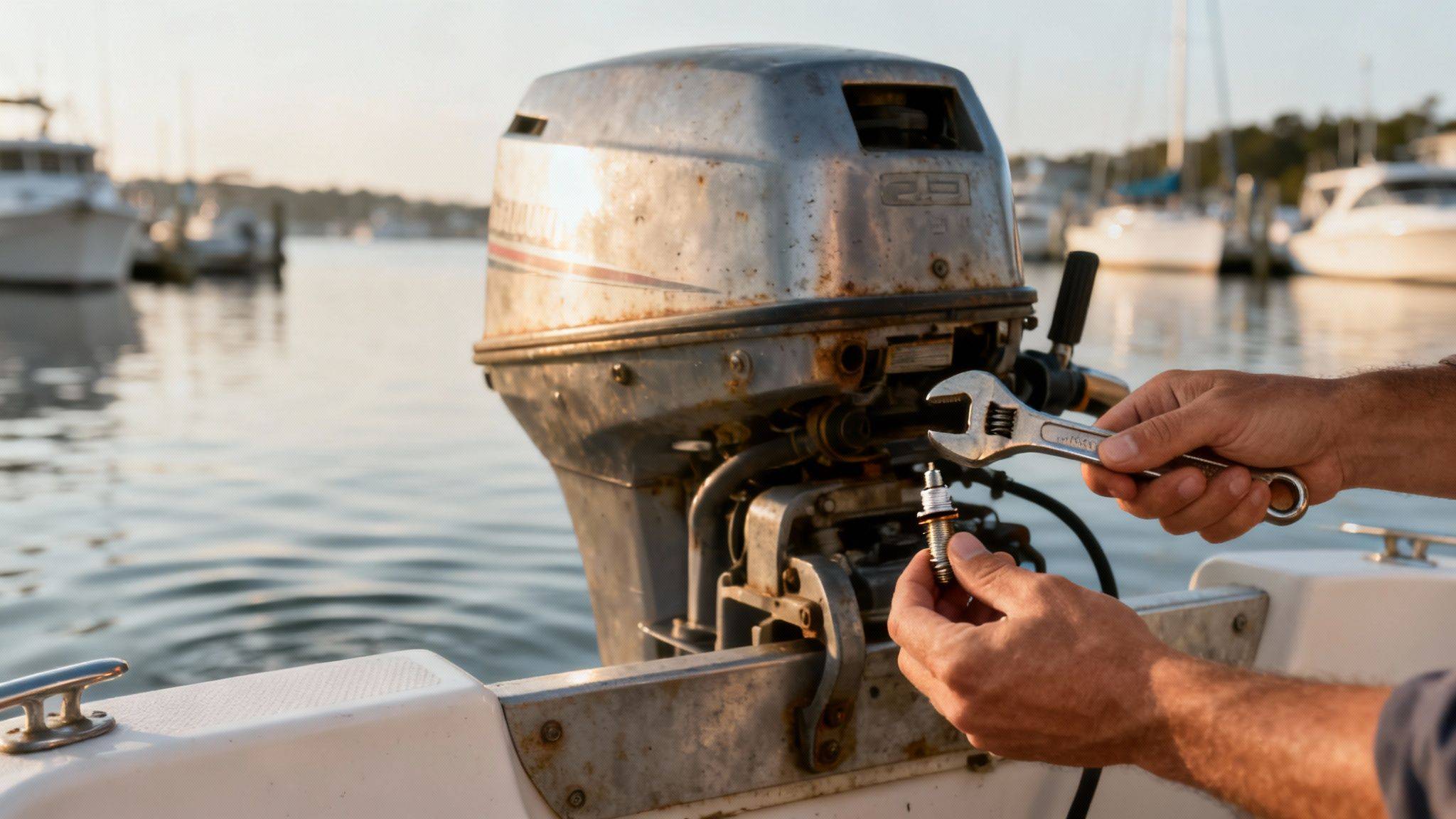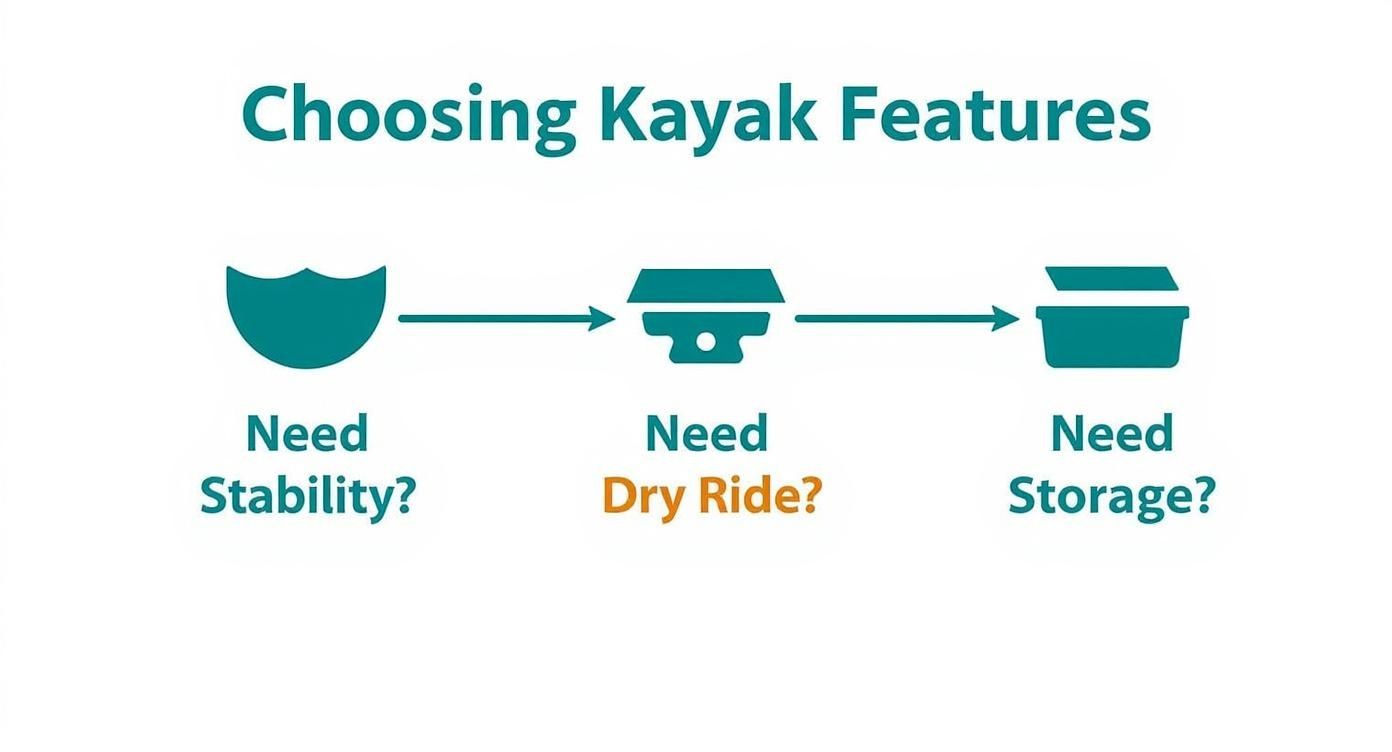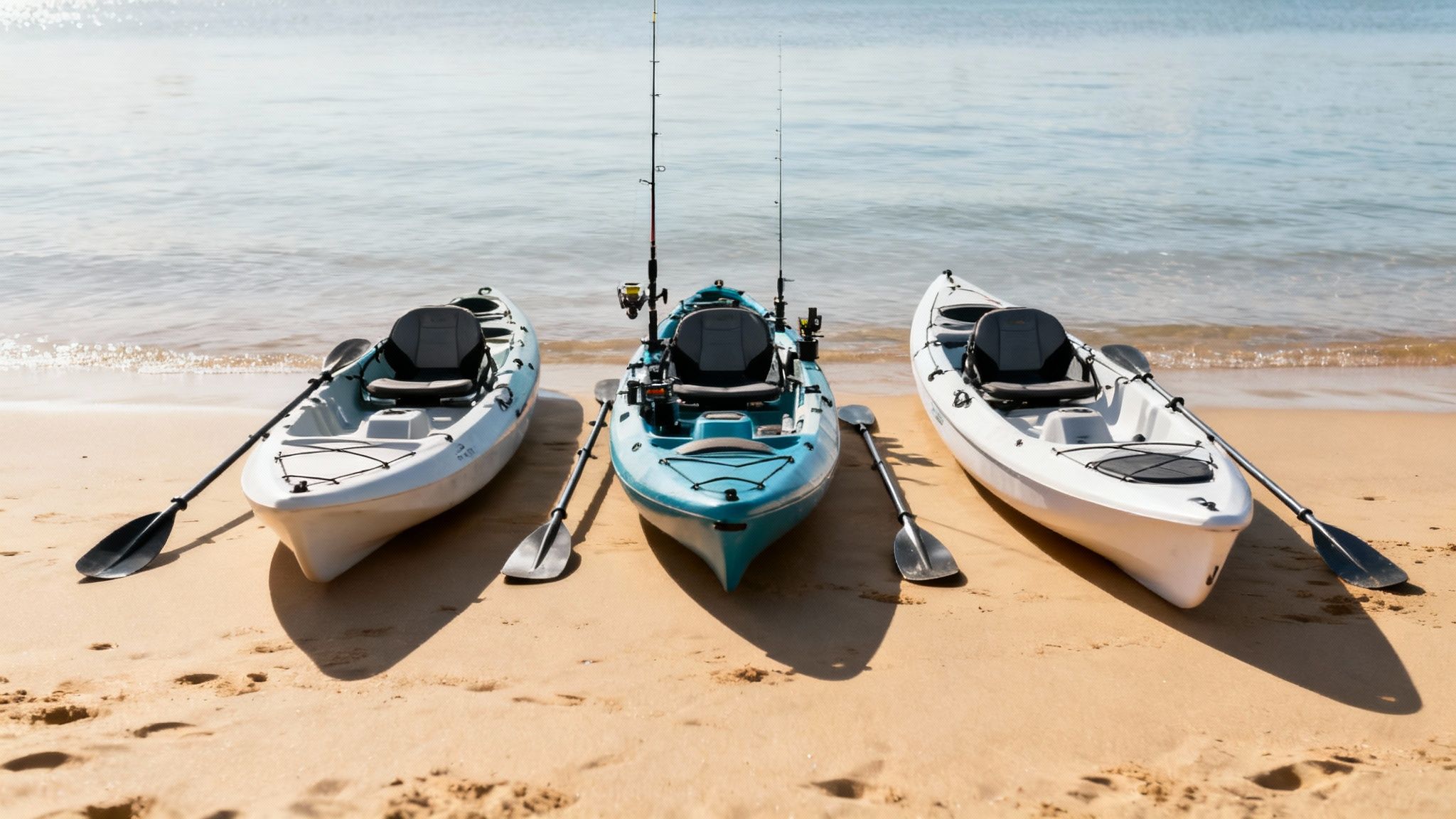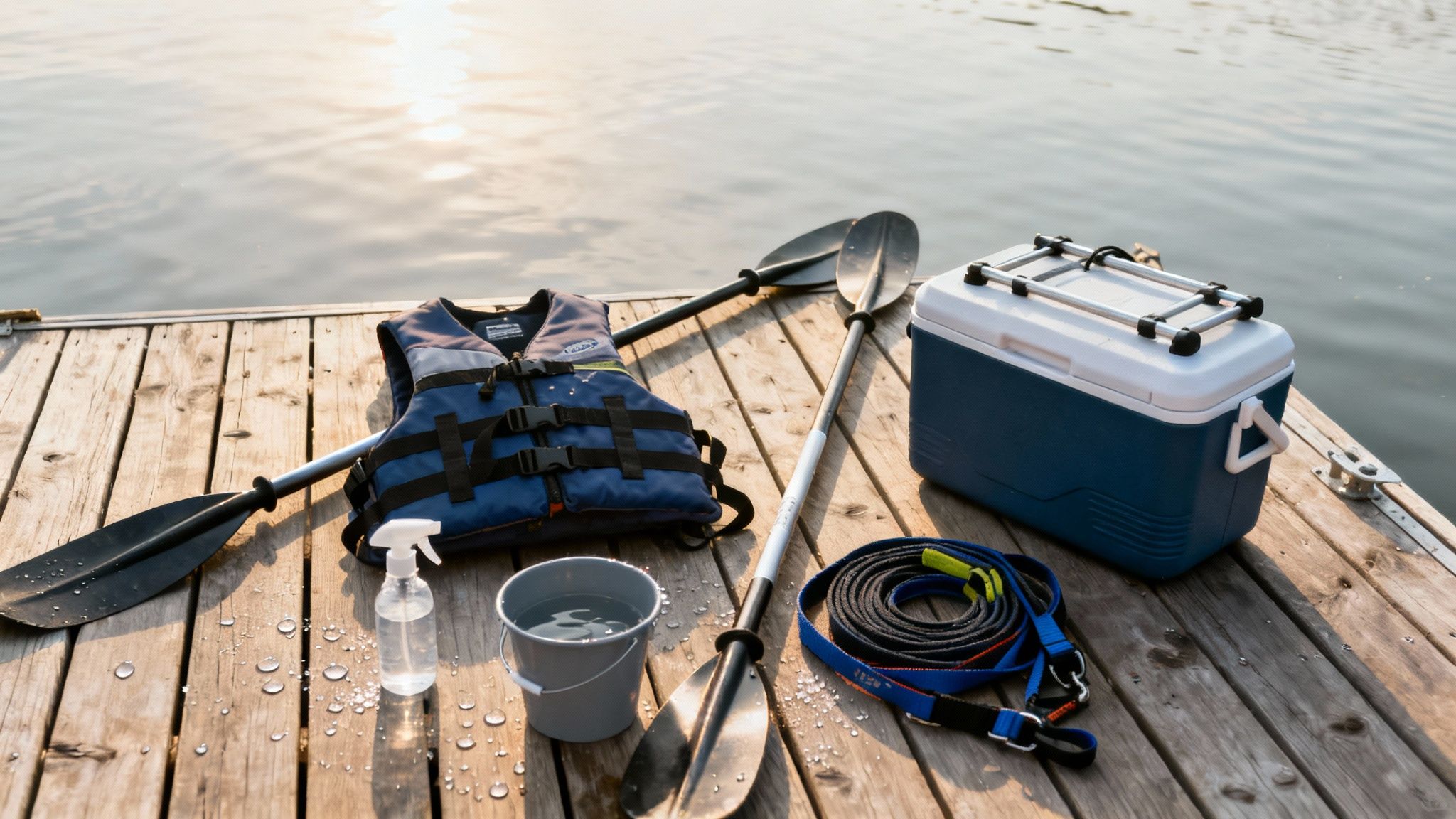
If you've ever felt a bit hesitant about traditional kayaking—the kind where you're snug inside a cockpit—then the sit-on-top kayak might just be your perfect entry into the water. Think of it as the ultimate user-friendly watercraft, blending the open freedom of a paddleboard with the comfort and stability of a boat.
At its core, a sit-on-top kayak has a sealed hull that you sit on, not in. This simple but brilliant design makes them incredibly stable and ridiculously easy to get on and off, which is why they’re a huge hit with beginners, anglers, and families looking for safe, straightforward fun.

Unlike a traditional sit-in kayak that encloses your lower body, the open deck of a sit-on-top gives you total freedom of movement. There’s no feeling of being trapped, which immediately removes one of the biggest hurdles for new paddlers.
If you happen to tip over, getting back on is as simple as sliding out of a pool. You just pull yourself back onto the deck. This self-rescue feature is a massive confidence booster and makes these kayaks an amazing platform for learning, swimming, or just kicking back and soaking up the Aussie sun.
The number one reason people love sit-on-top kayaks is their rock-solid stability. Most models have a wider, flatter hull that acts like the base of a pyramid, making it much harder to tip over. You feel secure on the water from the moment you launch, which is perfect for activities that need a steady hand, like fishing or photography.
Another fantastic feature tailor-made for our climate is the inclusion of scupper holes. These are small, clever holes that run from the deck right through the hull. Any water that splashes on deck from waves or your paddle simply drains straight out, so you’re never left sitting in a puddle.
The open-deck and self-draining design is more than just a convenience—it’s a core safety feature. It makes recovering from a capsize dramatically easier and faster, which is crucial for building the confidence every new paddler needs.
To help you get a quick handle on what makes these kayaks tick, here's a simple breakdown of their defining features.
This table sums up the essential characteristics of a sit-on-top kayak and explains why they're such a great match for Australian waters.
| Feature | Description | Primary Benefit for Australian Paddlers |
|---|---|---|
| Open Deck | Paddler sits on top of a sealed hull, not inside a cockpit. | Freedom of movement and easy entry/exit, perfect for swimming and warm weather. |
| Wide Hull | Generally wider and flatter than sit-in kayaks. | Exceptional stability, great for fishing, photography, and nervous beginners. |
| Self-Draining | Scupper holes allow water to drain off the deck. | Keeps the seating area dry and comfortable, ideal for coastal paddling and splashy fun. |
| Sealed Hull | The hull is a single, sealed unit, making it unsinkable. | Enhanced safety; the kayak won't fill with water even if it flips. |
These core design elements work together to create a boat that is approachable, safe, and incredibly versatile for just about any recreational paddler.
With our endless coastline and countless inland waterways, it’s no surprise the sit-on-top kayak has become a staple of Australia's paddling culture. Their stable, forgiving nature is perfectly suited to the diverse conditions we have, from calm lakes and rivers to gentle coastal bays.
This versatility makes them your go-to vessel for almost any casual water adventure. Whether you're planning a family outing or a solo fishing trip in a quiet estuary, these kayaks deliver a reliable and enjoyable experience. If you're looking for inspiration, check out our guide on the top destinations for boating in Australia.
Their soaring popularity is a direct reflection of how perfectly they align with our outdoor-loving, water-centric way of life.
A sit-on-top kayak might look pretty straightforward, but its design is a clever mix of features all working together to give you a stable, safe, and fun day on the water. Instead of just listing off parts, let's take a practical tour from front to back to see what each component actually does. Once you get the hang of these elements, you'll be able to compare models and know exactly how a kayak will feel before you even get it wet.
You'll quickly see that the design is all about the rider's experience. This focus on comfort is a massive trend, with Aussie kayakers increasingly looking for kayaks with moulded seatbacks and adjustable footrests. In fact, these features were found in over 650,000 kayaks sold worldwide in 2023, showing a huge global shift toward designs that make paddling more comfortable and get more people out on the water.
The hull is the entire bottom of your kayak, and its shape is the single biggest factor in how the boat handles. Think of it as the kayak's personality—some are built for speed, while others are all about rock-solid stability.
A wider, flatter hull creates a very steady platform, making it tough to tip over. This design is perfect for beginners, anglers who want to stand up and cast, or anyone who puts safety and security first. On the flip side, a narrower, V-shaped hull slices through the water with less effort, making it faster and better at staying in a straight line, but it'll feel a bit tippier.
The top side of the kayak, known as the deck, is where all the action happens. This is where you'll find all the practical, user-friendly features that make sit-on-tops so popular.
The combination of an open tank well for bulky gear and a sealed hatch for valuables gives you the best of both worlds. It’s this practical approach to storage that makes the sit-on-top kayak a favourite for day trips and fishing.
Two of the smartest features on a sit-on-top are all about managing water and keeping you as dry as possible.
The scupper holes, as we've mentioned, are small tunnels running from the deck right through the hull. They’re basically your kayak’s automatic drainage system. Any water that splashes onto the deck drains straight back out, so your seating area never fills up. For paddling in calm, flat water, you can pop in some scupper plugs to block these holes for an even drier trip.
The bow (the front) of the kayak is usually shaped to push waves and spray away from you, which really helps keep you dry when you're moving through choppy water. These simple but effective design choices make sure you stay comfortable, even on a splashy day. You can see these features up close by exploring the different models in our extensive range of kayaks.
Choosing between a sit-on-top and a sit-in kayak is probably the biggest decision a new paddler will make. It’s not about which one is "better" in general, but which one is better for you. This choice will shape your comfort on the water, your confidence, and the kinds of adventures you can have.
Think of it like this: a sit-on-top kayak is the convertible sports car of the water. It’s open, breezy, and perfect for a sunny day. A sit-in kayak, on the other hand, is more like a sedan—it offers more protection from the elements and better efficiency for long trips, but you're more enclosed.
The right choice really boils down to your personal paddling style, the local conditions you'll be facing in Australia, and what you want to get out of your time on the water. Let's break down the key differences to help you find your perfect match.
For most Aussies, the sit-on-top kayak is the clear favourite, and for good reason. Its biggest selling point is its incredible stability. The wider hull makes it feel planted and secure, which is a massive confidence booster for beginners, families with kids, or anyone feeling a bit nervous about tipping.
This stability is also a game-changer for anglers. It gives you a solid platform for casting, rigging your gear, and on some purpose-built models, even standing up. The open deck means you have total freedom of movement, so you’re never fumbling around inside a tight cockpit trying to grab your tackle.
But perhaps its most loved feature is how easy it is to get back on. If you take a dip—either by choice on a hot day or by accident—climbing back aboard is simple. You just pull yourself up and onto the deck. This self-rescue capability makes it an exceptionally safe option for recreational paddling.
While sit-on-tops win on stability and ease of use, sit-in kayaks have their own set of strengths. Their main advantage is speed and efficiency. The narrower, more hydrodynamic hull design lets them glide through the water with less effort, making them the go-to for longer journeys.
This design also gives them superior tracking—that’s the ability to hold a straight line without constantly needing to correct your course with the paddle. If you plan on covering serious distances or paddling in windy conditions, a sit-in kayak will be far less tiring.
Plus, the enclosed cockpit offers excellent protection from the elements. It shields your lower body from cold water, wind, and sun, which is a huge benefit for paddling in cooler weather or choppy seas. This drier ride is often the deciding factor for anyone who paddles outside of the peak summer months.
The infographic below works as a simple decision tree, helping you prioritise what matters most to you, whether it's stability, staying dry, or having plenty of storage.

As the guide shows, if rock-solid stability is your top priority, a sit-on-top with its wide hull is the way to go. If other factors are more important, your choice might lead you elsewhere.
To make the decision even clearer, we've put together a table that gives you a direct comparison of the most important features. Use it as a quick reference guide to see which kayak type lines up best with what you need.
Whether you're trying to compare different models or find the perfect vessel for a family outing, this breakdown will point you in the right direction. For a wider look at all your options, you can also explore our full range of boats and kayaks.
A direct comparison of key differences to help you choose the right kayak for your needs and paddling environment in Australia.
| Feature | Sit On Top Kayak | Sit In Kayak |
|---|---|---|
| Stability | Excellent. Wider hulls provide a very stable platform. | Good to Moderate. Narrower hulls can feel less stable. |
| Ease of Use | Very easy. Simple to get on and off, ideal for beginners. | Moderate learning curve. Requires practice to enter and exit. |
| Self-Rescue | Easy. You can climb back on from the water without assistance. | Difficult. Requires specific techniques like an Eskimo roll. |
| Dryness | You will get wet. Open deck offers little protection from splash. | Much drier. The cockpit and spray skirt keep water out. |
| Speed & Efficiency | Slower. Wider hulls create more drag in the water. | Faster. Sleek, narrow design glides through the water. |
| Best For | Recreation, fishing, family fun, warm weather. | Touring, long-distance paddling, cooler conditions. |
Ultimately, there's no single right answer. Your choice comes down to your adventure goals and what feels most comfortable for you.

Choosing your first—or next—sit-on-top kayak should be exciting, not overwhelming. With so many options out there in Australia, the real secret is matching the boat to your adventure. This guide will walk you through a simple way to compare models and features, so you end up with a kayak you’ll love for years to come.
The first step is always the most important: figure out your main reason for getting on the water. How you answer this question will steer every other decision, from the kayak’s length to the features you can’t live without.
Whether you're an angler searching for the best fishing kayak, planning a family outing, or looking to compare prices and features in your area, defining your primary use is key.
Your intended activity directly shapes the ideal kayak design. A boat built for fishing has a completely different set of priorities than one designed for a lazy family paddle.
Once you know what you'll be doing, you can start digging into the specs. The two most critical numbers are length and width, as they dictate the trade-off between speed and stability.
Think of it this way: a long, narrow kayak is like a racing bike—it’s fast and efficient but can feel a bit tippy. A short, wide kayak is more like a mountain bike—super stable and manoeuvrable, but it won’t be winning any speed races.
The relationship between length, width, and performance is the core principle of kayak design. Understanding this simple trade-off empowers you to look at any sit on top kayak and immediately grasp how it will handle on the water.
This knowledge is gold when you start to compare prices and features of kayaks in your area. A shorter, wider boat is often more affordable and perfect for recreational fun, while a longer, specialised kayak will have a higher price tag but deliver much better performance for touring or fishing. While we focus on hardshell kayaks here, you can explore other portable options by reading our guide to the best inflatable kayak for your weekend.
Beyond its size, a few other factors will make a huge difference to your experience on the water.
Weight Capacity: This one is non-negotiable. The total capacity must safely support you, all your gear, and your esky. Always choose a kayak with a capacity well above your expected total weight to ensure a safe and stable ride.
Material: Most sit-on-top kayaks in Australia are made from rotomoulded polyethylene. This plastic is incredibly durable, forgiving of the odd bump and scrape, and resistant to UV damage—making it perfect for our harsh sun.
Seat Comfort: Don't underestimate how important a good seat is. A simple moulded seat is fine for short trips, but for longer paddles, an adjustable, padded seat with proper back support will make a world of difference.
By starting with your primary use and then moving through these key considerations, you can confidently narrow down your options and find the perfect sit-on-top kayak for your next adventure.

Once you’ve got your sit-on-top kayak, the real adventure begins. But to make sure your time on the water is safe and fun, you’ll need a few key pieces of gear. This isn’t about spending a fortune; it’s about having the right tools for a great day out.
Think of your gear as a complete system with the kayak at its heart. Your paddle, safety vest, and transport setup all work together to make every trip a success, from your driveway to the waterway and back again.
There are three absolute essentials every kayaker needs: a paddle, a life jacket, and a way to get your kayak to the water. Picking the right ones will make a huge difference to your comfort and safety.
The Paddle: Your paddle is your engine. Look for one that’s lightweight to reduce fatigue and correctly sized for your height and the width of your kayak. A paddle that's too short will have you scraping your knuckles, while one that's too long is just plain inefficient.
The Personal Flotation Device (PFD): In Australia, wearing a PFD (or life jacket) is mandatory. Choose a comfortable, properly certified PFD that fits snugly but gives you a full range of motion for paddling. Modern kayaking PFDs are designed with large armholes for exactly this reason.
Transport Solution: Unless you live on the water's edge, you'll need a way to transport your sit on top kayak. Roof racks with kayak cradles or pads are the most common and secure method for cars. They spread the boat's weight evenly and stop it from shifting while you're driving.
Choosing the right gear isn't just a checklist—it’s an investment in your safety and enjoyment. A comfortable PFD and a lightweight paddle can be the difference between a short, tiring paddle and a full day of exploration.
Proper care is simple but absolutely vital for extending the life of your kayak and keeping it in top shape for years to come. A few easy habits after each trip will protect your investment from the harsh Australian elements.
The most important habit is to rinse your kayak with fresh water after every single use, especially after paddling in saltwater. Salt is corrosive and will degrade fittings and accessories over time. A quick hose-down is all it takes.
For anglers, looking after your equipment is just as important as caring for the kayak. After rinsing your vessel, take a moment to clean your rods and reels. For more specific advice, you might want to check out our guide on the 10 must-have fishing gear for new anglers, which also covers proper maintenance.
How you store your kayak has a massive impact on its lifespan. The rotomoulded plastic is tough, but bad storage can lead to a warped hull or UV damage.
The best way to store your sit on top kayak is upside down on its gunwales (the top edges), supported by padded bars or wide straps. This prevents pressure points from denting the hull. Never hang it by its handles or scupper holes, as this concentrates all the stress on small areas and can cause serious damage. Storing it indoors or under a cover will also protect it from long-term sun exposure.
To wrap things up, let's tackle a few of the most common questions paddlers have about sit on top kayaks. These quick answers should clear up any lingering doubts and get you ready to hit the water with confidence.
The best kayaks for recreational use are those that prioritise stability and ease of use. Look for models with wider, flatter hulls, as these are forgiving for beginners and perfect for casual paddling. Brands available in most Australian retailers that fit this description include FeelFree, Ocean Kayak, and Viking Kayaks. Check with your local water sports shop to see which models they have in stock, as "near me" availability can vary.
Absolutely. Many popular coastal and lakeside locations across Australia have rental businesses perfect for family outings. For example, in Sydney, you can hire kayaks at Manly Kayak Centre. In Queensland, Noosa is a fantastic spot with multiple rental operators along the Noosa River. In Melbourne, Kayak Melbourne offers city tours. The best approach is to search online for "kayak hire near [your chosen location]" to find the most convenient and highly-rated local option.
You sure can. In fact, they’re the go-to choice for the vast majority of kayak anglers. Many models are even designed specifically for fishing, coming factory-fitted with rod holders, gear tracks for accessories, and wide, stable platforms perfect for casting. The open deck gives you total freedom of movement to manage your gear—a massive advantage over the cramped cockpit of a sit-in kayak.
Great question, but don't stress—they are cleverly designed to be self-draining. You'll notice small channels called scupper holes that run straight from the deck through to the bottom of the hull. Any water from waves or paddle drip simply drains right back out. This design ensures the seating area never fills up like a bathtub, keeping you comfortable and the kayak sitting perfectly buoyant.
The self-draining feature is one of the most practical advantages of a sit on top kayak. It means less time bailing and more time paddling, which is exactly what you want on a fun day out.
If there's one trade-off, it's your exposure to the elements. Because you’re sitting on the hull rather than in a protective cockpit, you’re guaranteed to get a bit wet from splashes and paddle drip. This makes them less ideal for cold-weather paddling, where a sit-in kayak offers much better protection from wind and chilly water. For most of the year in Australia, though, this open-air feeling is a huge plus.
Ready to start your next water adventure? At Easy Inflatables, we specialise in high-quality, portable, and durable watercraft designed for Australian conditions. Explore our full range and find the perfect vessel for your family outings, fishing trips, and explorations. Check out our collection at https://easyinflatables.com.au.
Experience the ultimate freedom on the water with our top-quality inflatable boats and accessories. Easy Inflatables is your trusted partner, providing everything you need for a safe and unforgettable adventure.
At Easy Inflatables, we believe in empowering adventurers with high-quality inflatable solutions. Our commitment to durability and performance ensures that every product enhances your outdoor experiences.